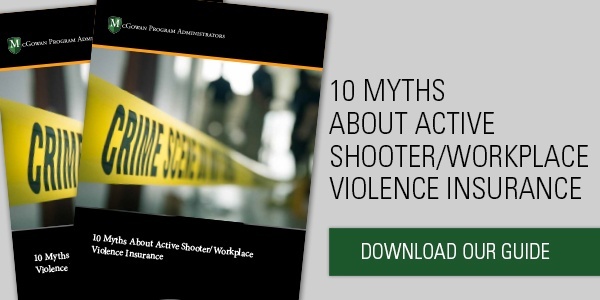Active shooter incidents almost always happen where people work or live. Therefore, it’s impossible to ignore the links between mass shootings and workplace/domestic violence.

As the accompanying table shows, just 9.4% of active shooter incidents between 2000 and 2013 happened in an open space, according to the FBI. The rest happened primarily in workplaces, except for the few at-home attacks.
Furthermore, the Occupational Safety and Health Administration (OSHA) reports:
- Workplace violence was the second-leading cause of death in U.S. job sites in 2016.
- Nearly 2 million American workers become victims of workplace violence every year.
News headlines reflect this reality: In December 2012, Adam Lanza murdered his mother before the Sandy Hook shooting. Nearly five years later, Kevin Neal killed his wife the night before opening fire on a California school. A rapid lockdown prevented a larger massacre from occurring there, but Neal eventually killed five people before dying in a police shootout.
“Domestic violence is prevalent in our society; mass shootings are not,” says Paul Marshall, director of McGowan’s Active Shooter/Workplace Violence Insurance Program. “But it’s worth noting the connection, as researchers have identified the key warning signs of abusers who are likely to kill in the future.”
Warning signs for domestic and workplace violence
Following up on its active shooter study, the FBI released an in-depth report in July 2017 suggesting that organizations and their leaders take proactive steps to identify dangerous people and intervene to prevent mass shootings. The FBI’s advice includes watching for clues in people’s worksite behavior and domestic relationships.
“These are not spontaneous, emotion-driven, impulsive crimes emanating from a person’s immediate anger or fear,” the FBI says. They are deliberately planned, often with extreme precision.
Indeed, the perpetrators do not always keep their intentions secret.
“One study found that over 70% of men who murdered their intimate partners explicitly threatened to do so beforehand,” the FBI report says.
According to the FBI, warning signs or triggers may include:
- Recent and significant personal loss or humiliation such as a death, breakup, divorce, or loss of a job or status.
- Stalking or otherwise paying inappropriate attention to a co-worker or family member.
- Statements pointing to suicide, end-of-life planning, or an interest in destructiveness.
- Obsessive research, planning, and preparation that has no reasonable connection to everyday life.
- Suddenly starting to amass weapons, ammo, and protective gear.
- Recent interest in explosive devices.
- Intense fascination with previous mass assaults in a way that seems inappropriate.
Forming a strategy to prevent active shootings
The FBI recommends a four-pronged strategy to identify potentially dangerous people and to act thoughtfully to prevent danger from escalating to physical harm.
- Concern reported — identifying the person posing a threat.
- Triage — assessing the seriousness of the threat, creating a response team, identifying protective measures, and investigating the threat further.
- Assessment — studying the results of the investigation, including factors likely to escalate the threat and factors likely to mitigate it.
- Management — protecting threatened people, determining the right course of action with the dangerous person, monitoring the situation closely, and reassessing regularly.
Making this work requires a commitment to thoughtful planning and follow-through, including:
- Empowering people to speak up about threats without fear of retaliation.
- Listening to people who cause concerns and making sure you understand their grievances. Often, simply listening to people de-escalates their violent intentions.
- Focusing on threatening behavior rather than mental illness or personality disorders. The behavior is the threat — not the illness or disorder.
- Committing to fairness and justice, with well-defined rules that are enforced equitably.
The FBI report is a must read for leaders who are directly responsible for the safety of their workforce. It includes several case studies demonstrating that a careful, well-thought-out intervention can prevent tragedies.
The question of liability in workplace violence incidents
If prevention fails, who is culpable in the litigation in the aftermath of a mass shooting? Even though OSHA includes workplace violence in its statistics, workers’ compensation policies generally insist that on-the-job injuries result directly from work being done.
If a woman’s ex-husband opens fire on her workplace, for instance, that’s domestic violence. In most cases, damages from these incidents will not be judged work-related. That’s one reason why workplaces should be covered by dedicated active shooter liability insurance.
Admittedly, it’s difficult to prevent every mass shooting or eruption of workplace violence — especially if violent people go to extravagant lengths to hide their intentions.
Most attackers, however, are not that careful. They provide clues. The safest response is to formulate a plan to identify those clues and intervene before it’s too late.
Related articles



